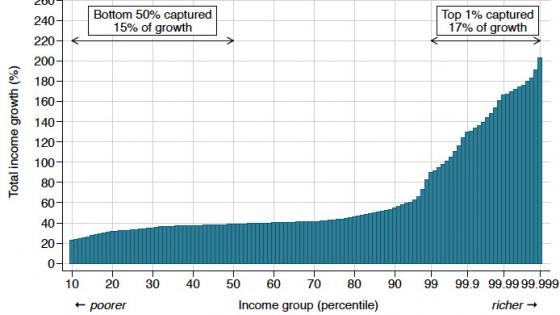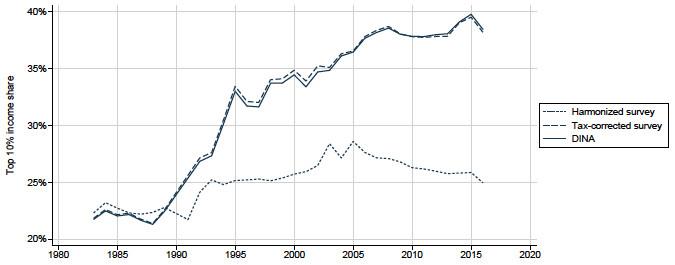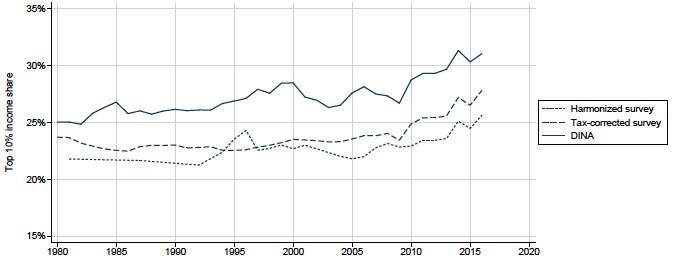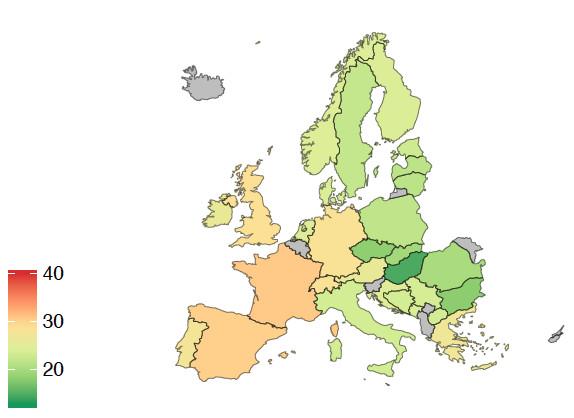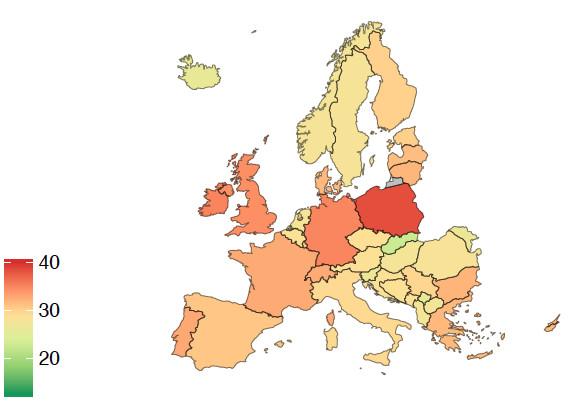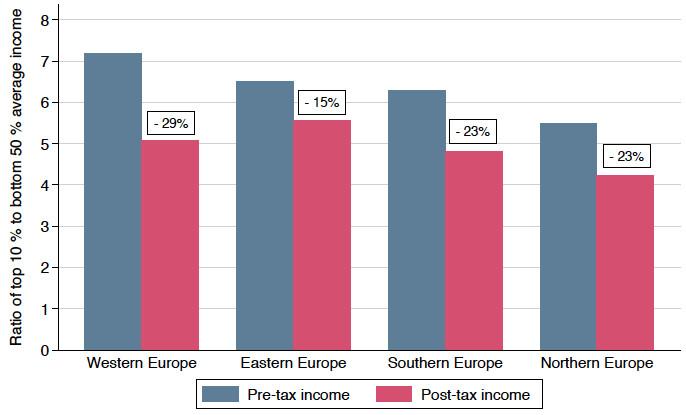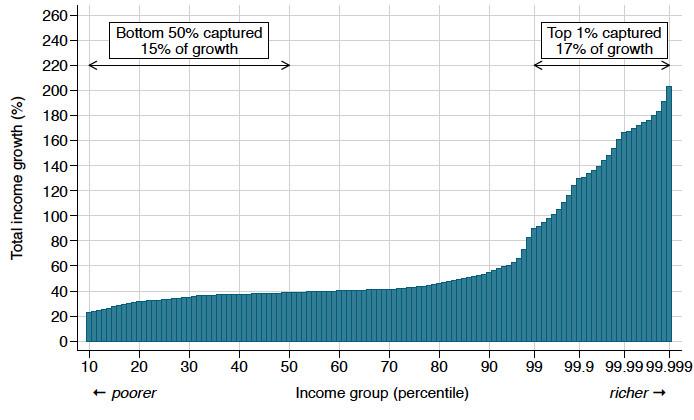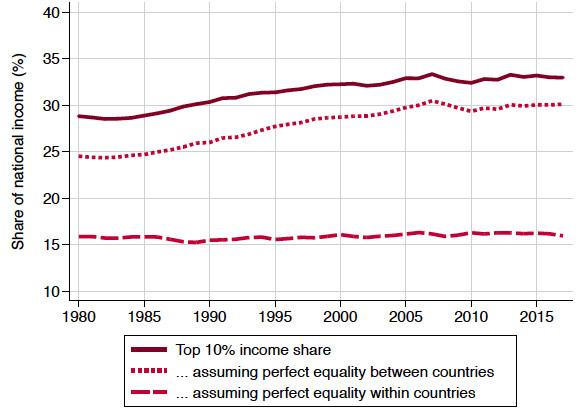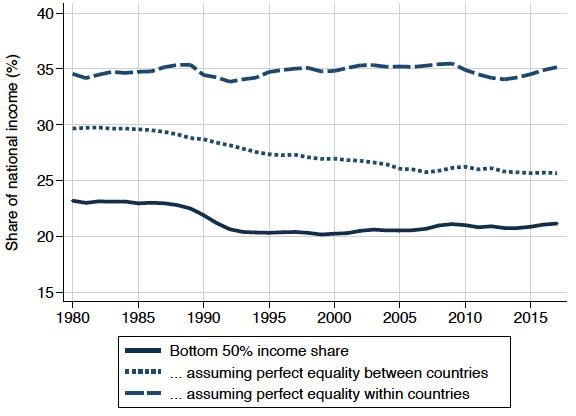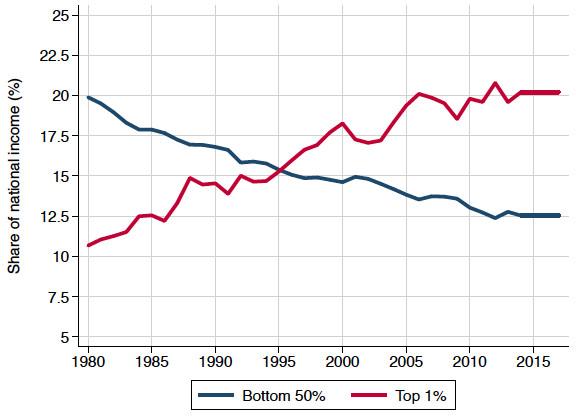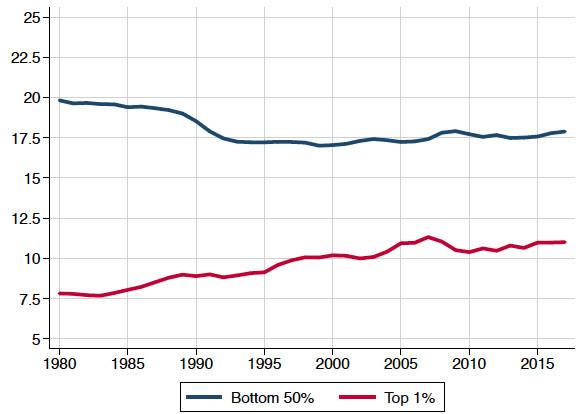Income and wealth inequalities have become increasingly present in public debates in recent years and have been the object of growing attention among policymakers. Sustainable Development Goal 10.1, adopted by the United Nations in 2015, requires that the incomes of the poorest 40% of a population grow faster than those of the entire population. The European Pillar of Social Rights, presented by the European Commission in 2017, similarly sets out 20 key principles to enhance social justice in the EU, including gender equality, equal opportunities, and the right to adequate minimum income benefits.
Yet, the existing academic literature has so far struggled to reconcile inequality estimates with macroeconomic growth figures. Recent studies have made significant advances in this direction by combining surveys, tax microfiles, and national accounts for the US (Piketty et al. 2018) and France (Garbinti et al. 2018), but the question of the long-run evolution of income disparities in Europe as a whole remains insufficiently understood.
In a new paper (Blanchet et al. 2019), we bring together all existing sources on income inequality in Europe since 1980 to produce distributional national accounts (Alvaredo et al. 2016) for 38 countries, spanning from Iceland to Malta and from Portugal to Moldova. That is, we distribute the entirety of national income to individuals —contrary to existing studies which usually focus exclusively on household income measured from surveys. Our estimates are fully consistent with official growth figures and are comparable across countries and time. Our series are available in open access from the World Inequality Database and come with an income comparator, which can be used to position users in the income distribution of their country, of Europe, and of the world as a whole.
Reconciling inequality estimates with national accounts
Existing data sources on inequality in Europe suffer from three types of biases. First, conceptual discrepancies can arise in surveys or tax data when welfare concepts available are not comparable, due to differences in available income definitions (e.g. pre-tax income or post-tax income) or to differences in available equivalence scales (e.g. per adult, per capita, or per household). Second, surveys may not be representative of the true income distribution, due to well-known issues of nonresponse or misreporting of top incomes (Alvaredo et al. 2018). Finally, some components of national accounts may not be reported in either surveys or tax data, but nonetheless contribute directly or indirectly to personal incomes. These include imputed rents, which correspond to the rental value of housing that homeowners pay to themselves, and the retained earnings of corporations, which correspond to profits that are kept within the company rather than distributed to shareholders but do contribute to increasing their wealth.
We develop a new methodology to systematically address these three biases. First, we compute comparable estimates of pre-tax-income (before direct taxes and transfers, but after social contributions and pension benefits) and post-tax-income (after taxes and transfers) inequality among adults by relying on survey microdata and using a machine-learning algorithm (Friedman 2001, Chen and Guestrin 2016) to impute these concepts when only limited historical survey tabulations are available. Second, we use survey calibration methods (Blanchet et al. 2019) to combine our harmonised survey estimates with fiscal income shares available from the World Inequality Database, which ensures that top incomes are better represented. Finally, we distribute imputed rents and retained earnings based on national accounts figures and distributions of owner-occupied housing and stock ownership obtained from the European Statistics on Income and Living Conditions and the European Household Finance and Consumption Survey.
Our main concepts of interest are pre-tax income (income received by individuals after the operation of the pension and unemployment insurance systems, but before the operation of the tax and social transfer systems) and post-tax income (pre-tax income, minus all direct and indirect taxes plus all social benefits in cash or in kind).
Figure 1 shows how bringing together surveys, tax data, and national accounts can greatly improve traditional survey-based estimates. In Poland, fiscal (pre-tax) top income shares obtained from Bukowski and Novokmet (2017) reveal a large and growing underrepresentation of top incomes in surveys. After correction, the top 10% pre-tax income share appears to be underestimated by more than 10 percentage points in 2017. By contrast, surveys are more efficient at measuring top incomes in Denmark, but accounting for the large share of undistributed profits accruing to resident households (more than 8% of GDP in recent years) leads to important upward revisions of inequality at the top end.
Figure 1 From surveys to national accounts: Inequality in Poland and Denmark, 1980-2017
(a) Poland
(b) Denmark
Source: Blanchet et al. (2019). According to survey data, the top 10% pre-tax income share in Poland is 25% in 2017. When completing survey data with tax data and other non-fiscal components of income, this value reaches about 38%. See www.wid.world/europe2019 for data series and technical details.
Inequalities have risen in a majority of European countries since 1980
Combining surveys, tax data, and national accounts in a systematic manner gives us access to an entirely new database on inequality in Europe, covering the 1980-2017 period from the bottom of the distribution to the top 0.001%. Based on our estimates, we document a long-run rise in pre-tax-income disparities, which we map in Figure 2. Eastern Europe used to be the least unequal region of the continent but caught up with Western and Southern Europe as the transition from communism to capitalism in the 1990s led to large increases in income concentration.
Figure 2 Top 10% pre-tax-income shares in Europe, 1980 versus 2017
a) 1980
b) 2017
Source: Blanchet et al. (2019). The top 10% pre-tax income share in Germany was 28% in 1980 and rose to 35% in 2017. See www.wid.world/europe2019 for data series and technical details.
Pre-tax income inequality levels – and ‘predistribution’ policies – remain the main determinant of post-tax inequality among EU countries, but redistribution does play an important role. Figure 3 compares the ratio of the top 10% average income to the average income of the bottom 50% before and after accounting for taxes and transfers in 2017. In Eastern Europe, fiscal regimes reduce this gap by 15% on average. This is significantly lower than in Southern Europe and Northern Europe, and nearly twice as lower as in Western Europe, where redistribution decreases inequalities by 29%.
Figure 3 Pre-tax versus post-tax income inequality in Europe, 2017
Source: Blanchet et al. (2019). In 2017, the top 10% earn on average 7.2-times more than the bottom 50% before taxes and transfers, and 5.1-times more after the operation of the taxes and transfers system. See www.wid.world/europe2019 for data series and technical details.
European inequalities are primarily due to inequalities within countries
Reconciling surveys and tax data with national accounts allows us to go beyond nations and aggregate inequality statistics at the level of Europe as a whole. Rising inequalities in Europe appear to have been mainly driven by dynamics visible at the very top of the income distribution. In the past four decades, the poorest 80% Europeans’ average incomes grew by about 20% to 50% (Figure 4). As soon as one looks at richer income groups, however, growth rates are markedly higher, exceeding 100% for the top 1% and culminating at 200% for the top 0.001% of European citizens. Between 1980 and 2017, the top 1% alone captured 17% of European-wide growth, compared to 15% for the bottom 50%.
Figure 4 Income inequality and growth in Europe: Growth incidence curve, 1980-2017
Source: Blanchet et al. (2019). Between 1980 and 2017, the per adult real pre-tax income growth rate of the top 0.001% was 200%, five times more than the growth rate of the bottom 80% of the population (about 40%). See www.wid.world/europe2019 for data series and technical details.
The level and evolution of income inequality in Europe are due to what occurs within countries rather than to differences in average standards of living or macroeconomic growth rates across countries. This becomes clear when comparing actual inequality levels to two counterfactual scenarios: one in which European countries would perfectly converge in their average national incomes (isolating inequalities within countries), and one in which European citizens would all earn the average income of their country of residence (isolating inequalities between countries). Results from this simple decomposition point to the primary importance of the former component: the share of total income received by top 10% earners in Europe as a whole would only decrease from 33% to 30% in case of perfect macroeconomic convergence, while it would boil down to 15% if there were no inequalities within countries. Using a formal Theil decomposition, we estimate accordingly that over 75% of European inequalities are accounted for by the within-group component.
Figure 5 Between-country versus within-country inequalities in Europe, 1980-2017
a) Top 10% income share
b) Bottom 50% income share
Source: Blanchet et al. (2019). In 2017, the top 10% income share in Europe was 33%. If all countries were to converge in their average national incomes per adult, it would decrease to 30%. If all citizens within countries were to earn the average national income of their country, by contrast, it would be as low as 15%. See www.wid.world/europe2019 for data series and technical details.
Europe has been more successful than the US at curbing inequalities
While inequalities have increased in Europe, the old continent remains substantially less unequal than the US (Figure 6). In the US, top-1% earners used to capture 10% of pre-tax national income in 1980 and receive 20% today; by contrast, in Europe as a whole, the top-1% share only grew from 7.5% to 11%. These diverging trajectories have had very tangible effects on the purchasing powers of low-income citizens: bottom-50% earners saw their average pre-tax income increase by 40% in Europe but only 3% in the US. The poorest half of the population earns an average annual income of €17,100 in Western Europe, compared to €13,000 in the US.
Figure 6 Income inequality in Europe and in the US, 1980-2017
a) United States
b) Europe
Source: Blanchet et al. (2019). Between 1980 and 2017, the top 1% pre-tax income share in the US rose from 10.7% to 20.2%. In Europe, this share rose from 7.8% to 11.1% over the same period. See www.wid.world/europe2019 for data series and technical details.
Conclusion
Despite rising income disparities since the 1980s, driven by fast-growing incomes at the top, Europe remains the least unequal region of the world, thanks to a more equal distribution of income before taxes and transfers. European social models, by providing relatively equal access to public education, healthcare and fair jobs, have been more successful than the US in addressing the challenges posed by technological change and trade globalisation, which are now known to affect low-skilled workers (Autor et al. 2014).
The rise in top income inequality in Europe still suggests that there is scope for improvement. In a context of increasing tax competition, a majority of European countries have engaged in the process of decreasing corporate tax rates, reducing top marginal income tax rates, and partly compensating budget losses by relying on indirect taxation. These dynamics can have important consequences on both pre- and post-tax distributions and limit the ability of European countries to finance their social models in an equitable way.
References
Alvaredo, F, T Atkinson, L Chancel, T Piketty, E Saez and G Zucman (2016), “Distributional national accounts guidelines”, WID.world Working Paper 2016/2.
Alvaredo, F, L Chancel, T Piketty, E Saez and G Zucman (2018), World Inequality Report, Cambridge US: Harvard University Press.
Autor, D H, D Dorn, G H Hanson and J Song (2014), “Trade adjustment: Worker-level evidence”, The Quarterly Journal of Economics 129(4): 1799-1860.
Blanchet, T, L Chancel and A Gethin (2019), “How unequal is Europe? Evidence from distributional national accounts”, WID.world Working Paper 2019/6.
Blanchet, T, I Flores and M Morgan (2018), “The weight of the rich: Improving surveys using tax data”, WID.world Working Paper 2018/12.
Bukowski, P, and F Novokmet (2017), “Top incomes during wars, communism and capitalism: Poland 1892-2015”, LSE Working Paper 17.
Chen, T, and C Guestrin (2016), “XGBoost: A scalable tree boosting system”, Proceedings of the 22nd ACM SIGKDD International Conference on Knowledge Discovery and Data Mining, San Francisco US, August 13–17, 785-794.
Friedman, J H (2001), “Greedy function approximation: A gradient boosting machine”, The Annals of Statistics 29(5): 1189–1232.
Garbinti, B, J Goupille-Lebret and T Piketty (2018), “Income inequality in France, 1900–2014: Evidence from distributional national accounts (DINA)”, Journal of Public Economics 162: 63-77.
Piketty, T, E Saez, and G Zucman (2018), “Distributional national accounts: Methods and estimates for the United States”, Quarterly Journal of Economics 133(2): 553– 609.
